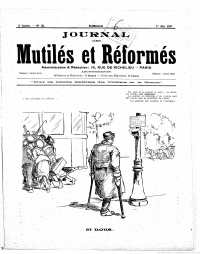Founding the Veterans' Association↑
With nearly 1 million members by 1939, the Union fédérale (UF) was the largest veterans’ association in interwar France. It was founded in Lyon in February 1918 as a federation of provincial veteran and war-wounded (mutilés) associations. Its recruitment was not restricted to men who had seen active service during the war – the UF had several women in its leadership. The association produced three national publications – La France mutilée, Cahiers de l’UF and Notre France – as well as editing its own version of the Journal des mutilés et réformés, the only veterans’ newspaper available at newsstands. The UF was active in the international veterans’ community. It favoured rapprochement with Germany through the Conférence intenationale des associations de mutilés et anciens combattants, and counted future Nobel Peace Prize winner René Cassin (1887-1976) amongst its leading members.
Aims↑
Like all French veterans’ associations, the UF campaigned ceaselessly for the improvement of veterans’ pensions and for the involvement of ex-servicemen in government. The most prominent figure in the association was Henri Pichot (1884-1945), who became its president in 1934. Under Pichot, the UF remained close to the democratic Radical Party and, unlike its rival, the Union nationale des combattants (UNC), rejected collaboration with the extreme right. However, as war approached and the French Third Republic faltered, the UF gave its backing to the UNC’s campaign for an authoritarian regime under Marshal Philippe Pétain (1856-1951). In August 1940, the UF was incorporated into Vichy France’s Légion française des combattants.
Chris Millington, Swansea University
Section Editor: Emmanuelle Cronier
Selected Bibliography
- Millington, Chris: The French veterans and the Republic. The Union nationale des combattants and the Union federale, 1934-1938, in: European History Quarterly 42/1, 2012, pp. 50-70.
- Millington, Chris: From victory to Vichy. Veterans in inter-war France, Manchester 2012: Manchester University Press.
- Prost, Antoine: Les anciens combattants et la société française, 1914-1939, 3 volumes, Paris 1977: Presses de la Fondation nationale des sciences politiques.
- Prost, Antoine: In the wake of war. 'Les ancien combattants' and French society, Oxford 1992: Berg.










